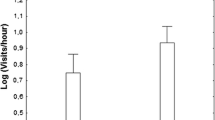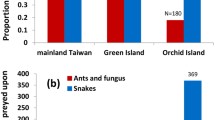Summary
Two models predicting the temporal patterns of parental investment in offspring defense over the nesting cycle were tested. The first is based on offspring age, the other on the vulnerability of offspring to predation. Both models make very similar predictions for altricial species after eggs have hatched, i.e., increases in intensity of parental defense until fledging. For precocial species, however, the post-hatching predictions of each model are different: the offspring age model predicts a continued increase in defense intensity, while the vulnerability model predicts a decline. I examined the temporal patterns of parental defense of a precocial shorebird, the killdeer (Charadrius vociferus), and determined which model was supported. Killdeer responses to human and natural predators were observed. Killdeer were less willing to leave the nest, responded most intensely, and displayed closest to a potential predator around hatching. Defense intensity increased from early to late incubation as predicted by the offspring age model. However, after hatching killdeer parental defense declined for both males and females, thus supporting the vulnerability model for this stage. Males and females responded significantly differently to all types of predators. Males took greater risks, remained on the nest longer, defended offspring more intensely, and displayed closer to the predator than females at the approach of a potential predator. Responses to natural predators depended on the type of predator and the approach made by the predator; a greater range of defense behavior was used for predators approaching on the ground compared to aerial predators. In general, killdeer responses to humans were more intense and less variable than their responses to natural predators. This was most likely because the human intruder approached nests and chicks more directly and closer than natural predators.
Similar content being viewed by others
References
Andersson M, Wiklund CG, Rundgren H (1980) Parental defense of offspring: a model and an example. Anim Behav 28:536–542
Armstrong EA (1956) Distraction display and the human predator. Ibis 98:641–654
Ashkenazie S, Safriel UN (1979) Time-energy budget of the Semipalmated Sandpiper (Calidris pusilla) at Barrow, Alaska. Ecology 60:783–799
Barash DP (1975) Evolutionary aspects of parental behavior: distraction display of the alpine accentor. Wilson Bull 87:367–373
Bengtson SA (1970) Breeding behaviour of the Purple Sandpiper Calidris maritima in West Spitsbergen. Ornis Scand 1:17–25
Bent AC (1929) Life histories of North American shorebirds. Part 2, US Natl Mus Bull 142
Biermann GC, Robertson RJ (1981) An increase in parental investment during the breeding season. Anim Behav 29:487–489
Brown RG (1962) The aggressive and distraction display behavior of the Western Sandpiper Ereunetes mauri. Ibis 104:1–12
Brunton DH (1986) Fatal antipredator behavior by Killdeer. Wilson Bull 98(4):605–607
Brunton DH (1987) Reproductive effort of male and female Killdeer (Charadrius vociferus). PhD dissertation University Michigan, Ann Arbor, Michigan
Brunton DH (1988a) Sexual differences in time budgets of Killdeer during the breeding season. Anim Behav 36:705–717
Brunton DH (1988b) Energy expenditure in reproductive effort: the reproductive strategies of male and female Killdeer (Charadrius vociferus). Auk 105:553–564
Buitron D (1983) Variability in the responses of Black-billed Magpies to natural predators. Behaviour 78:209–236
Burger J (1981) Sexual differences in parental activities of breeding Black Skimmers. Am Nat 117:975–984
Curio E (1975) The functional organization of antipredator behaviour in the Pied Flycatcher: a study of avian visual perception. Anim Behav 23:1–115
Curio E, Regelmann K, Zimmerman U (1984) The defence of first and second broods by Great Tit (Parus major) parents: a test of predictive sociobiology. Z Tierpsychol 66:101–127
East M (1981) Alarm calling and parental investment in the Robin, Erithacus rubecula. Ibis 123(2):223–230
Erpino MJ (1968) Nest-related activities of Black-billed Magpies. Condor 70:154–165
Gibson F (1971) The breeding biology of the American Avocet Recurvirostra americana in central Oregon. Condor 73:444–454
Gochfeld M (1984) Antipredator behavior: aggressive and distraction displays of shorebirds. In: Burger J, Olla BL (eds) Shorebirds: breeding behavior and populations. Plenum Publ. Corp., New York, pp 289–377
Gottfried BM (1979) Anti-predator aggression in birds nesting in old field habitats: an experimental analysis. Condor 81:251–257
Gramza A (1967) Responses of brooding Nighthawks to a disturbance stimulus. Auk 84:72–86
Greig-Smith PW (1980) Parental investment in nest defense by Stonechats (Saxicola torquata). Anim Behav 28:604–619
Harvey PH, Greenwood PJ (1978) Antipredator defence by Stonechats (Saxicola torquata). Anim Behav 28:604–619
Hobbs JN (1972) Breeding of Red-capped Dotterel at Fletcher's Lake Dareton, NSW. Emu 72:121–125
Howe MA (1982) Social organization in a nesting population of eastern Willets (Catoptrophorus semipalmatus). Condor 84:88–102
Hussell D, Page GW (1976) Observations on the breeding biology of the Black-bellied Plovers on Devon Island, N.W.T., Canada. Wilson Bull 88:632–653
Jones A (1979) Notes on the behaviour of the Variable Oystercatcher. Notornis 26:47–52
Jourdain FC (1936) The so-called injury feigning in birds. Oologists Rec 16:25–37
Komeda S (1983) Nest attendance of parent birds in the Painted Snipe. Auk 100:48–55
Kruuk H (1964) Predators and anti-predator behavior of the Black-headed Gull (Larus ridibundus L.). Behav Suppl 11:1–129
Larson S (1960) On the influence of the Arctic fox (Alopex lagopus) on the distribution of Arctic birds. Oikos 11:277–305
Lazarus J, Inglis IR (1986) Shared and unshared parental investment, parent-offspring conflict and brood size. Anim Behav 34:1791–1804
Lemmetyinen R (1971) Nest defence behaviour of Common and Arctic Terns and its effects on the success achieved by predators. Ornis Fenn 48:13–24
Lenington S (1980) Bi-parental care in Killdeer: an adaptive hypothesis. Wilson Bull 92(1):8–20
Maclean GL (1973) A review of the biology of the Australian Desert Waders, Stilta and Peltohyas. Emu 73:61–70
Maxson SJ, Oring LW (1980) Breeding season time and energy budgets of the polyandrous Spotted Sandpiper. Behaviour 74:200–263
Merritt PG (1984) Observer recognition by the Northern Mockingbird. J Field Ornithol 55:252–253
Montevecchi W, Porter J (1980) Parental care and related behavior before fledging in Northern Gannets (Morus bassanus) with reference to other marine birds. In: Burger J, Olla B, Winn H (eds) Behavior of marine animals. Vol. VI. Marine birds. Plenum Press, New York, pp 323–366
Montgomerie RD, Weatherhead PJ (1988) Risks and rewards of nest defence by parental birds. Q Rev Biol 63:167–187
Mundahl JT (1982) Role specialization in the parental and territorial behavior of the Killdeer. Wilson Bull 94(4):515–530
Myers JP (1978) One deleterious effect of mobbing in the Southern Lapwing (Vanellus chilensis). Auk 95:419
Nol E (1980) Factors affecting the nesting success of the Killdeer (Charadrius vociferus) on Long Point, Ontario. M.S. thesis, University Guelph, Guelph, Ontario
Nol E, Lambert A (1984) Comparison of Killdeer, Charadrius vociferus, breeding in Mainland and peninsula sites in Southern Ontario. Can Field Nat 98:7–11
Patterson TL, Petrinovich L, James DK (1980) Reproductive value and appropriateness of response to predators by White-crowned Sparrows. Behav Ecol Sociobiol 7:227–231
Phillips RE (1972) Sexual and agonistic behavior in the Killdeer (Charadrius vociferus). Anim Behav 20:1–9
Pierotti R (1981) Male and female parental roles in the Western Gull under different environmental conditions. Auk 98:532–549
Ratcliffe DA (1977) Observations on the breeding of the Golden Plover in Great Britain. Bird Study 23:63–116
Regelmann K, Curio E (1983) Determinants of brood defence in the Great Tit Parus major L. Behav Ecol Sociobiol 13:131–145
Shields WM (1984) Barn Swallow mobbing: self-defence, collateral kin defence, group defence, or parental care? Anim Behav 32:132–148
Simmons KEL (1955) The nature of the predator reactions of waders towards humans, with special reference to the role of the aggressive-, escape- and brooding-drives. Behaviour 8:130–173
Skutch AF (1949) Do tropical birds rear as many young as they can nourish? Ibis 91:430–455
Trivers RL (1972) Parental investment and sexual selection. In: Campbell B (ed) Sexual selection and the descent of man, 1871–1971. Aldine Press, Chicago, pp 136–179
Vogt W (1938) Preliminary notes on the behavior and ecology of the eastern Willet. Proc Linn Soc NY 49:8–42
Walters JR (1982) Parental Behavior in Lapwings (Charadriidae) and its relationships with clutch sizes and mating systems. Evolution 36:1030–1040
Weatherhead PJ (1979) Do Savannah Sparrows commit the Concorde Fallacy? Behav Ecol Sociobiol 5:373–381
Weatherhead PJ (1982) Risk-taking by red-winged blackbirds and the Concorde Fallacy. Z Tierpsychol 60:199–208
Author information
Authors and Affiliations
Rights and permissions
About this article
Cite this article
Brunton, D.H. The effects of nesting stage, sex, and type of predator on parental defense by killdeer (Charadrius vociferous): testing models of avian parental defense. Behav Ecol Sociobiol 26, 181–190 (1990). https://doi.org/10.1007/BF00172085
Received:
Accepted:
Issue Date:
DOI: https://doi.org/10.1007/BF00172085




